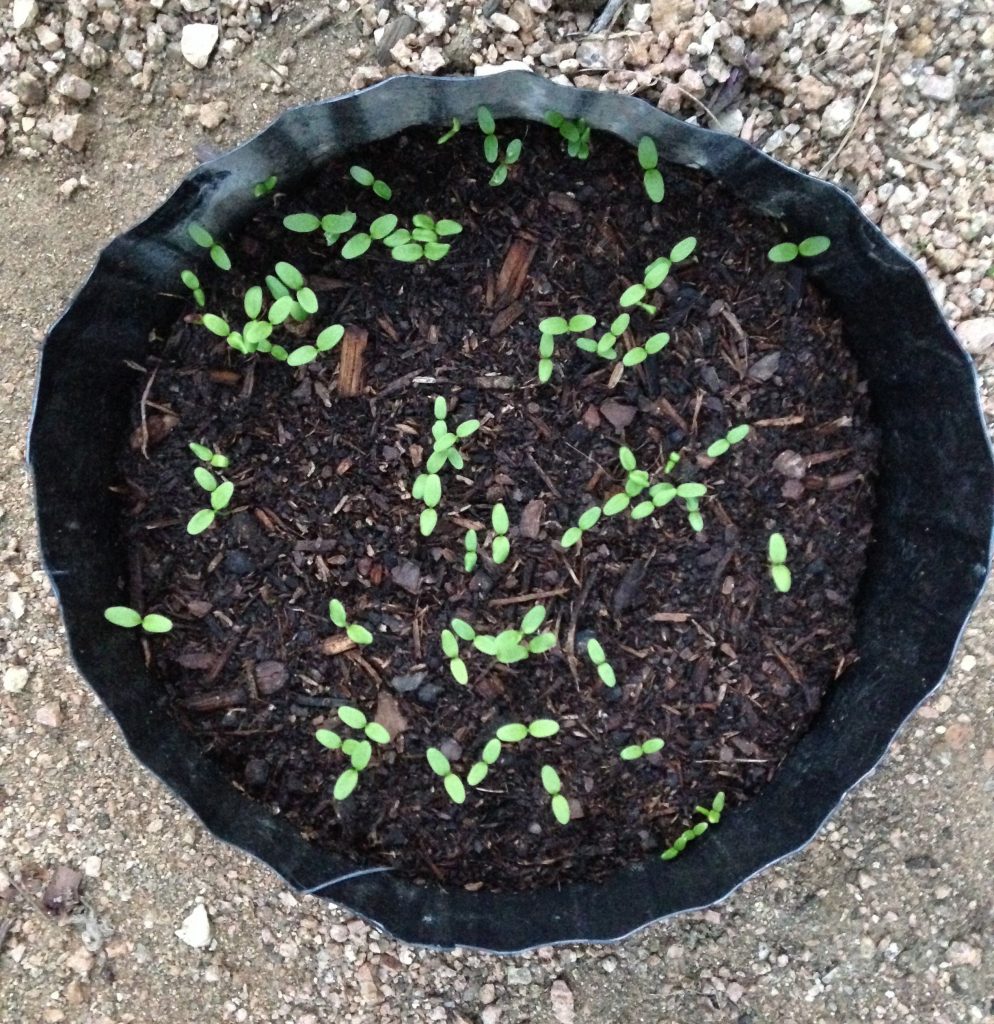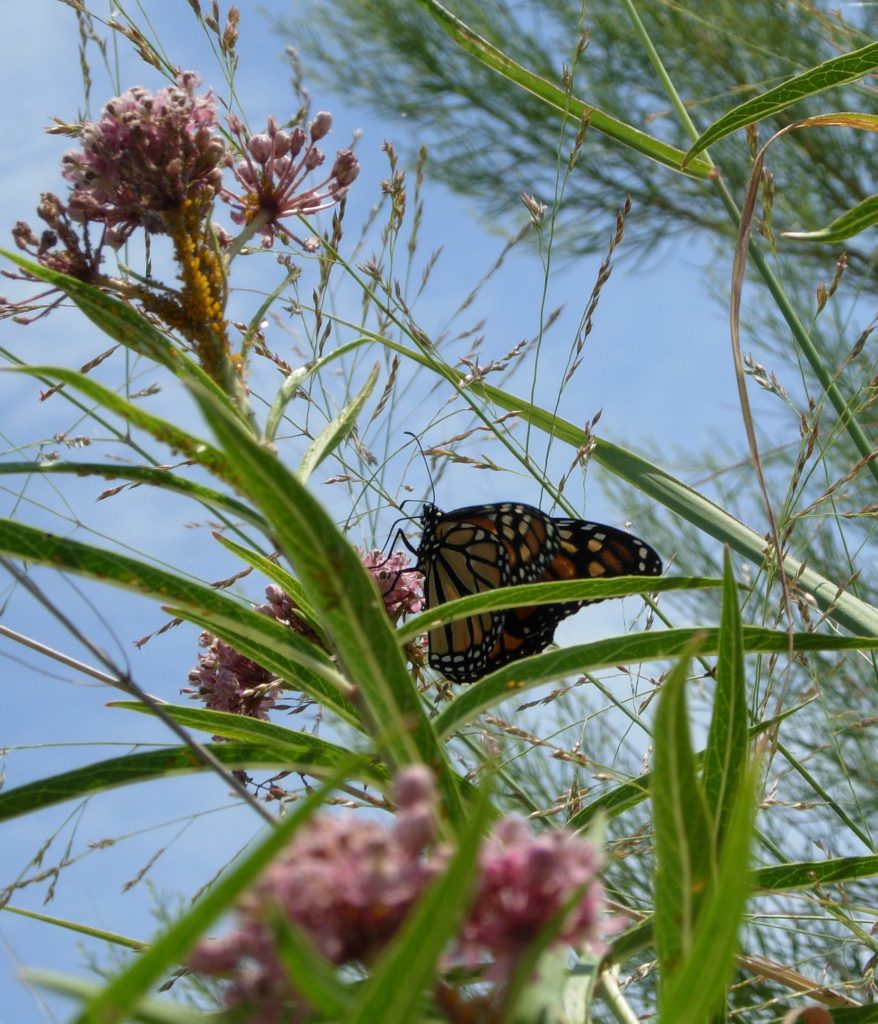Crazy, erratic weather arrived in Texas–again–this week, bringing freezing temperatures to much of the state. Last Saturday temperatures rose to the 80s; by noon on Sunday it was 27 degrees. Surely plants and insects must be grossly confused and butterfly gardeners like me start thinking: what should we plant in our gardens?
Since Monarch butterflies are about to leave their overwintering roosts in Michoacán and head our way, it’s impossible to not consider milkweed, the only plant on which Monarch butterflies will lay their eggs. A cold winter in San Antonio that included four “polar vortexes” has frozen all our milkweed to the ground, leaving little or nothing for the migrating insects to host on if they show up in the next few weeks. Even sturdy Asclepias asperula, Antelope Horns, which we usually see at the ranch by now haven’t shown their nubby heads.
Dr. Chip Taylor, founder of Monarch Watch, told us via email this week that looking ahead, average temperatures are likely to prevail for the next 40 days, according to Accu-weather. “That’s a more favorable forecast than the one from the National Oceanic and Atmospheric Association,” he wrote. In his seasonal blogpost assessing the beginning of the 2014 Monarch migration, Dr. Taylor had speculated that temperatures would be higher than normal in Texas for March and April. “Which wouldn’t be good,” he said.
Why?
It seems counterintuitive, but it creates a bad situation when early spring is warmer than usual because the Monarchs disperse further north faster. That can cause them to get ahead of the milkweed plants they need to lay their eggs and provide food for hatching caterpillars. When they travel further north too early, they arrive in locations where milkweed has neither germinated nor produced leaves for them to eat. On top of that, subsequent cold spells are more likely to occur as they move further north–and this can kill eggs and caterpillars they leave behind in the erratic weather.

Asclepias curassavica, Tropical milkweed seeds, were planted in February and are just showing their delicate leaves. Photo by Monika Maeckle
While the weather continues its uncertain patterns one thing is for sure: we should all be planting milkweed.
I dropped some Asclepias curassavica, Tropical Milkweed, and Asclepias incarnata, Swamp milkweed, into several black buckets in early February and the sprouts are poking their dainty heads above the soil mix right now. In about two weeks, I’ll re-pot those seedlings into two-inch square containers for later transplanting in the garden and sharing with friends.
You should all do the same. If not with Tropical Milkweed, the most widely available, easy-to-grow variety, then with your local natives collected from the wild or bought at native nurseries and seed suppliers. Check out the Texas Butterfly Ranch Milkweed Guide for details.
Native plant purists sometimes contest the planting of Tropical milkweed outside of its natural range, which would limit it to parts of Mexico. They suggest that it might cause disease or encourage migrating Monarchs to break their diapause and stick around locally. I don’t buy that argument, especially when Monarchs are in such great need of milkweed and Tropical milkweed is the only one widely available commercially. To me, that’s like saying you’re not going to feed a starving child anything but locavore, organic produce. Given the circumstances, we can’t afford to be so choosy. Read more about the Tropical milkweed quandary in this post.
However, for those who live in warm climates where Tropical milkweed might survive a mild winter, best practices suggest we should chop it to the ground at the end of the fall so any undesireable spores that may carry disease won’t have the chance to fester on its stalks and be passed along to the next generation. This year’s ample freezes took care of that for 2014.
While you’re waiting for those milkweed sprouts to take root, please sign our petition encouraging First Lady Michelle Obama to plant milkweed at the White House garden. The First Lady has been lauded for planting an organic vegetable garden at 1600 Pennsylvania Avenue, and for encouraging Americans to get out and get active through her Let’s Move initiative. We feel that planting milkweed–Asclepias syriaca, Common milkweed, perhaps–in between the rows of broccoli and tomatoes at the White House would be an apt expression of her priorities, while also helping to raise awareness of the dramatic decline of the Monarch migration.
If you agree, please join us by signing our petition.
Like what you’re reading? Follow butterfly and native plant news at the Texas Butterfly Ranch. Sign up for email delivery, like us on Facebook, or follow us on Twitter, @monikam.
More stories like this:
- Texas Butterfly Ranch Milkweed Guide
- How to Get Native Milkweed Seeds to Germinate
- Persnickety Texas milkweeds, May Not Lend Themselves to Mass Production
- Tropical Milkweed: To Plant it or Not is No Simple Question
- Desperately seeking Milkweed: Be sure to buy pesticide free plants
- Butterfly FAQ: Is it OK to Move a Chrysalis? Yes, and here’s how to do it
- How to Make Seedballs
- Converting your Lawn to a Butterfly Garden



The small island of Bermuda, out in the Atlantic ocean 700 mile east of South Carolina, provides us with insight on the question of whether or not planting tropical milkweed north of its natural range causes monarchs that use it to suffer serious disease problems
http://www.coldwellbankerislands.com/seo/islands/ber2.jpg
The monarch population there didn’t exist until after the native cedar/palmetto forests were cut down by european colonists in the 1600’s to make room for agriculture and settlements. Sometime in the 1600’s, 1700’s or early 1800’s two weedy non-native invasive tropical milkweeds (Asclepias currassavica and Gomphocarpus physocarpus) became established on the disturbed ground. Monarchs were very abundant in the late 1800’s: http://imageshack.com/a/img839/268/nmim.jpg
To this day monarchs continue to do well on Bermuda using the same non-native milkweeds they have used there for the past 150+ years. There is even a monarch conservation group in Bermuda dedicated to conserving the monarch via planting more non-native tropical
milkweed: http://bermudamonarch.org/index.html Bermuda is about the same latitude as Dallas, Texas.
Hello! I am in Long Beach, CA. I put in a new garden last summer and accidentally planted tropical milkweed instead of native. I was immediately rewarded with lots of butterflies. I was a little worried when I saw some in January laying eggs on my nearly bare plants. Now I am in my fourth generation of caterpillars and I have run out of milkweed. They are crawling around my yard, trying to find the tiny plants I let grow from seed. I went to to the nursery and couldn’t get natives, so bought some gallons of tropical. The nursery tells me alot of gardeners are overrun and they can’t keep the milkweed in stock–probably since the butterflies didn’t migrate this year. Not all of my caterpillars will survive, but some of the biggest have already made it to chrysalis. After this generation, I am going to pull out the tropical and plant native. Thank you for being a great resource! I hope to restore the balance by introducing native milkweed next season.
Hello Monica-
I came across your blog googling info on butterflies. I really enjoy your blog! Your writing style, look and feel of your site, pertinent and varied info you introduce, plus a “plethora” of photos you include in almost every post. Your love and passion is clearly visible throughout your whole site. You are a true mariposista!
Besides giving kudos and heaping accolades on you, I wish to address your emergency need for more milkweed plants after yours were ravaged by marauding mobs of munching monarch larvae.
https://texasbutterflyranch.com/2012/04/12/desperately-seeking-milkweed-voracious-appetites-of-monarch-butterfly-caterpillars-create-milkweed-emergency/
I recently read an interesting online article written by a person who has had the same problem (me too!). When running out of milkweed, they feed their cats pumpkin! They included photos that showcased orange frass, so they were definitely eating it. I crosschecked with several other online queries, and they all attest to its success.
One caveat: according to several sources, pumpkin and other members of the squash family will only support late instar caterpillars; it may have something to do with pumpkin not being its natural food, early instar cats feeding on it are lacking various nutrients normally found in milkweed, but late instar specimens are so close to pupating that it gets them by until they do so.
Articles specifically mention pumpkin, as summer and fall is usually when milkweed mass gets low, and pumpkins abound for Halloween. Again, other members of the squash family seem to work also. I haven’t tried it yet myself, although at least now I’m armed with this information.
p.s. I was born in Venezuela, where we too had gorgeous and varied butterfly species like you discovered on your Central America trip. I like you was unaware of them until much later and living in the U.S. Couldn’t help though notice the birds and giant iguanas, especially the macaw couples flying at sunset back to their roosts after hunting for food during the day.
I signed up for your newsletter and am looking forward to reading more of your excellent posts.
Regards,
-Andy
There is a typo in the letter to the First Lady, “nectar.”
Thank you